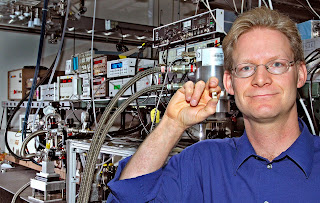Improved control of 'neglected middle-child' frequency range offers potential benefits
ALBUQUERQUE, N.M. — Sandia National Laboratories researchers have taken the first steps toward reducing the size and enhancing the functionality of devices in the terahertz (THz) frequency spectrum.
By combining a detector and laser on the same chip to make a compact receiver, the researchers rendered unnecessary the precision alignment of optical components formerly needed to couple the laser to the detector.
The new solid-state system puts to use the so-called "neglected middle child" frequency range between the microwave and infrared parts of the electromagnetic spectrum.
Until now, however, sensitive coherent transceiver (transmitter/receiver) systems were assembled from a collection of discrete and often very large components. Similar to moving from discrete transistor to integrated chips in the microwave world and moving from optical breadboards to photonic integrated circuits in the visible/infrared world, this work represents the first steps toward reduction in size and enhanced functionality in the THz frequency spectrum.
The work, described in the current issue (June 27, 2010) of "Nature Photonics," represents the first successful monolithic integration of a THz quantum-cascade laser and diode mixer to form a simple, but generically useful, terahertz photonic integrated circuit — a microelectronic terahertz transceiver.
With investment from Sandia's Laboratory-Directed Research and Development (LDRD) program, the lab focused on the integration of THz QCLs with sensitive, high-speed THz Schottky diode detectors, resulting in a compact, reliable solid-state platform. The transceiver embeds a small Schottky diode into the ridge waveguide cavity of a QCL, so that local-oscillator power is directly supplied to the cathode of the diode from the QCL internal fields, with no optical coupling path. ###
The Sandia semiconductor THz development team, headed by Michael Wanke, also included Erik Young, Christopher Nordquist, Michael Cich, Charles Fuller, John Reno, Mark Lee — all of Sandia labs — and Albert Grine of LMATA Government Services, LLC, in Albuquerque. Young recently joined Philips Lumileds Lighting Co., in San Jose, Calif.
Sandia National Laboratories is a multi-program laboratory operated by Sandia Corporation, a wholly owned subsidiary of Lockheed Martin Corporation, for the U.S. Department of Energy's National Nuclear Security Administration. With main facilities in Albuquerque, N.M., and Livermore, Calif., Sandia has major R&D responsibilities in national security, energy and environmental technologies, and economic competitiveness.
Sandia news media contact: Neal Singer, nsinger@sandia.gov (505) 845-7078 Sandia media relations contact: Stephanie Hobby, shobby@sandia.gov (505) 844-0948 WEB: DOE/Sandia National Laboratories















No comments:
Post a Comment